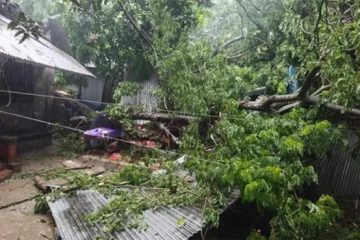Shahidul Islam Chowdhury
Residents of six cities are not only angry at the acute shortage of water, but are disgusted that the little amount of tap-water they get is contaminated, malodorous and tastes awful.
Many of them have been suffering from waterborne diseases after drinking the contaminated water which stinks even after prolonged boiling.
Mindless dumping of industrial wastes in water bodies including rivers and canals, excessive use of chemical pesticides and fertilizers in farmlands and unabated cutting of supply lines by ill-trained mechanics have contaminated the water and made it undrinkable, said scientists and authorities.
‘I could not go to school today as I had to wait in the queue to collect drinking water from the roadside pump as we hardly get water from the pipes at home,’ Shefali, 8, a class II student at a school in Modhubagh, told New Age on Wednesday.
Ruhul Amin, a banker living in Lalbagh, said that at rare moments they do get water from the pipes. ‘But drinking that water and taking a bath with it is repugnant since it smells so bad,’ he said.
The water crisis is, more or less, prevailing in almost all areas of the capital. Shortage of water is also a common complaint of citizens in other major cities — Chittagong, Rajshahi, Sylhet, Khulna and Barisal. Some residents of Chittagong alleged that the water is saline while Rajshahi citizens say that it contains iron.
Professor M Ruhul Amin of the Dhaka Child Hospital told New Age on Thursday that they have been getting more patients suffering from Typhoid, mainly a water-borne disease, in the last one year.
Irresponsible dumping of industrial and human waste in the rivers, including the Buriganga River which once made the Mughals choose Dhaka as a provincial capital, and the Turag, Balu, and Sitalakhshma, and increasing use of chemical pesticides and fertilizers in farming and defecation in the open are sources of water pollution, according to scientists.
Apart from groundwater sources, the rivers Buriganga and Sitalakhshma are important sources of water for Dhaka city as the Halda River is for Chittagong city.
Professor Shah Mohammad Ullah of the Department of Soil, Water and Environment of the University of Dhaka told New Age that microbiological pollution, mainly caused by defecation in the open and organic pollution, and the presence of metals like lead, chromium, mercury, nickel and copper due to the dumping of the wastes of tanneries and various industries have polluted the waters of the Buriganga and Sitalakhshma.
The level of oxygen in the water should be at least six per cent for the survival of aquatic fauna, he said. ‘But, at times, the level of oxygen becomes zero in the Buriganga water, making life for almost all organisms impossible.’
If the water of the Buriganga and Sitalakhshma is not properly treated, it can cause many maladies including skin diseases and stomach disorder, damage the kidneys, lungs and nervous systems and retard the growth of children, he warned.
According to a joint survey by the Department of Environment and the Canadian International Development Agency, more than 7,000 big, medium and small factories — including textile mills, tanneries, distilleries, pharmaceutical units, engineering workshops, chemical and pesticide factories, jute mills, and units producing rubber, plastic, food, sugar, paper and pulp, cement, fertiliser — are located along the rivers and canals in and around Dhaka and are dumping highly toxic untreated wastes into the water everyday. Hospitals and private clinics also throwing their wastes into the drains that flow into the rivers. Most of the human excreta of the city’s residents directly goes down to the rivers and canals through underground pipelines as nearly 70 per cent of their houses are not connected to the excreta treatment plant in Pagla.
Sources in Dhaka WASA admitted that the water treatment plants currently use more chemicals — especially chlorine and ammonium sulphate — since the pollution level in the surface water remains high.
When asked about the shortage of water, Dhaka WASA’s deputy managing director, Md Liakat Ali, claimed that WASA supplies 1,800 million litres of water everyday while the demand is for 2,000 million litres. ‘Of the total water supply, 86 per cent is collected from 504 deep tube-wells and the remaining 14 per cent from surface water including that of Buriganga and Sitalakhshma.’
He said there are only 2,64,000 legal water connections which is grossly inadequate since the number of city dwellers is more than 12 million, and is increasing everyday.
When asked about the quality of the water supplied, he blamed river pollution for the bad smell.
‘There is, however, no health risk in consumption of the water we supply,’ he claimed.
‘Though it stinks, it is absolutely safe as we test the water every hour before supplying it.’
‘We can free the water absolutely from the bad odour by mixing it with additional chemicals. But we do not do so as applying those chemicals will not be wise as they are harmful for the human body,’ he said.
The successive governments over the years have allowed industrialists to flout the rules and pollute the rivers, canals and wetlands in and around the city to such an extent that surface water has turned pitch black in several spots.
State Minister for Environment and Forest Mustafizur Rahman said in the parliament that many industries have set up effluent treatment plants. ‘But those plants start working only during inspection, but remain closed soon after the inspectors leave the place, and untreated wastes are discharged again from the factories,’ he said. ‘We will not allow this malpractice for long. The polluting factories will be shut down unless they set up ETPs and use them fully.’
Courtesy of www.newagebd.com




















